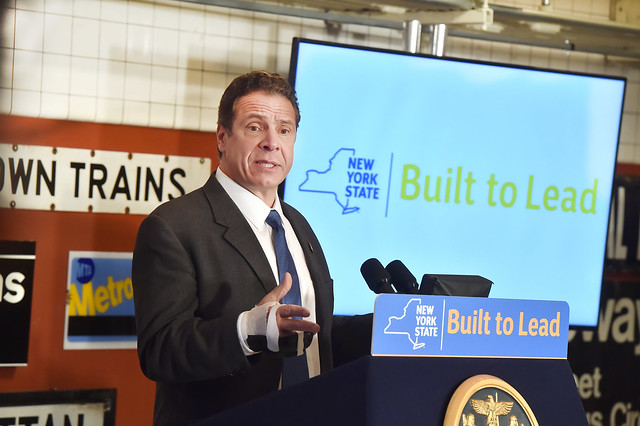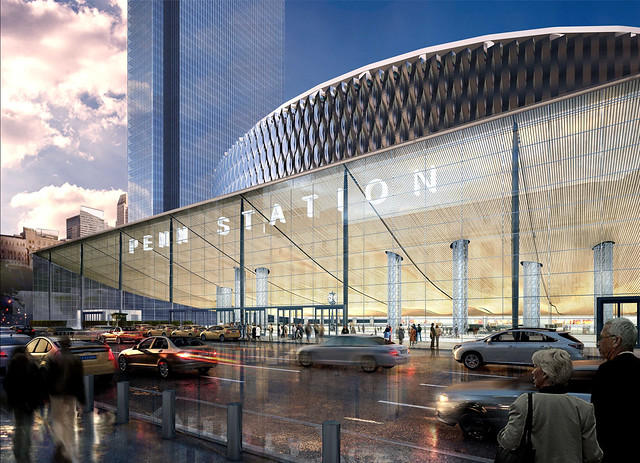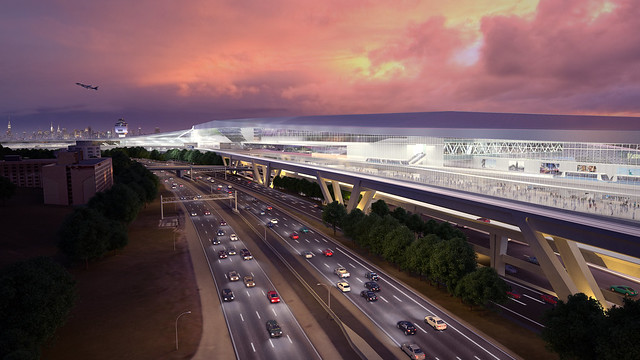
From the Transit Museum yesterday, Gov. Cuomo announced a series of initiatives to bring the MTA into the 21st Century. (Kevin P. Coughlin/Office of Governor Andrew M. Cuomo)
Installing wifi at all underground subway stations by the end of the year; bringing mobile ticketing to the LIRR and Metro-North within six months and a form of contactless payment to the subways by 2018; completing B Division countdown clocks by 2018; speeding up station rehabilitation work and overhauling the look and feel of our subway stations — all are noble goals and all were part of Gov. Andrew Cuomo’s agenda for improving the MTA and attracting more New Yorkers to mass transit. But following a press event high on lofty rhetoric about increasing transit use, the proposal seemed to indicate that the governor doesn’t understand exactly what the city’s pressing transit needs are.
After spending a week criss-crossing the state, announcing a spate of infrastructure projects that will affect New York for the next decade, if not longer, Cuomo found himself Friday morning out of his element. The last stop on his whirlwind tour was the Transit Museum, a perfect monument to best laid plans that often go awry. During Friday’s announcement, Gov. Cuomo played headliner to MTA CEO and Chairman Tom Prendergast’s undercard. In a later press gaggle, Cuomo admitted he doesn’t take the subway as often as he used to and explained that he’s “not an expert an international expert on the best transit systems.” He has consultants who are, he noted.
He unequivocally said that mass transit growth is the way forward for downstate New York growth, but he made these statements amidst a monument both to New York City past and to a future that never was. After all, the Transit Museum lives in a 1930s-era subway station that was supposed to be the Brooklyn portal for a Second Ave. Subway still not completed. What better place to try to hold back a flood by sticking a proverbial finger into a dike?
The MTA investments Cuomo and Prendergast announced are badly needed for purposes of modernity and will improve MTA operations. If Cuomo can prod the MTA to complete a series of seemingly stalled technological improvements the MTA has been trying to launch for a decade or more, his program will be judged a success. But as with the Penn Station plans, without an ongoing and far-reaching commitment to expand transit capacity, these subway projects too will look like political lipstick for our proverbial pig.
So what, you may be wondering, of the plans themselves? In addition to state support for the MTA’s five-year, $28 billion capital plan, Cuomo ushered in a series of other improvements. Here they are:
Wi-Fi At All Underground Stations By The End of the Year
The MTA and Transit Wireless have installed service at around half of all underground stations, and the rollout for the other half was supposed to wrap in 2017. Now, that timeline will be accelerated so full underground connectivity will be achieved by the end of this year. Tunnels will not be wired, but riders waiting for their trains will be able to takes calls and connect to the Internet at every underground station.
Mobile Payment and Ticketing Initiatives

Coming Soon: QR codes for your smart phone.
We’ve heard about the MTA’s Metrocard replacement efforts for years, and while the wheels are spinning, the ball isn’t moving forward. Now, Cuomo and Prendergast say the subways will begin accepting contactless payment system in 2018. Renderings show a QR code-based reader that isn’t exactly a cutting edge technology, and Prendergast later noted to reporters that this reader system may be an interim solution on the way to a full overhaul of the fare payment technology. Until we know more about this plan, I’m not convinced it’s the right approach, let alone a cure-all, to an ongoing problem. Metro-North and the LIRR will offer mobile ticketing by the end of the year — so I assume Cuomo is confident he can solve the labor problems that have been a barrier to implementation on the LIRR.
Countdown Clocks on the B Division
Countdown clocks — and the lack thereof in many stations — took center stage, and Prendergast said the MTA would wrap installation of B Division (that is, the lettered subway lines) countdown clocks by the end of 2018. Cuomo’s subsequent press release hedged on the date and simply said the MTA will “accelerate” installation but didn’t include a timeline. This is a promise from the MTA to continue to do what it has long said it would do but perhaps on a faster timeline maybe.
Other Technological Improvements
Cuomo and Prendergast also announced a laundry list of other proposals focused around “improving the customer experience.” These include USB charging ports on subway cars and new buses, wifi-enabled buses, and additional digital information screens including more On The Go kiosks and Help Point intercoms.
A New Focus on Station Rehabilitation Efforts

The MTA will close these 30 stations at times over the next few years to speed up rehab efforts. (Click to enlarge)
Finally, in a move that generated a lot of questions, the MTA announced a new approach to station rehabilitation efforts. Instead of stop-and-start weekend work and only partial closures, the MTA, at the request of its contractors, will close stations for concentrated periods of time to speed up the timing and efficiency of station work. Inspired by the Montague Tube work and in conjunction with its contractors, the MTA feels it can be more efficient in this system repair work by closing stations for weeks (or months) at a time rather than suffering through years of weekend diversions. In fact, the agency does this now, but usually only at stations around the edges.
Tom Prendergast discussed this focused effort. “In many cases the customers say its better that for 6-8 weeks, I need to do something different rather than for 42 weeks on weekends and nights our lives are totally disrupted,” he said.
As part of this effort, the MTA will tackle 30 stations over the next three-to-five years. Most will be finished by 2018 with a few trickling into 2020. It’s not clear whether these are in addition to the 20 stations identified in the five-year capital plan or encompass those 20 stations that were due for rehab work. In conjunction with this work, the MTA will “revamp the design guidelines for subway stations to improve their look and feel” and implement this new plan at these 30 stations. The plans will include “cleaner, brighter stations [that will] be easier to navigate, with better and more intuitive wayfinding, as well as a modernized look and feel.” Considering these stations are all single- or side-track platforms that aren’t hard to modernize, this philosophy sounds better tailored to overhauling transfer points or big hubs, but a fresh look is a welcome development.
Already, New Yorkers in Astoria and Clinton Hill, to name a few neighborhoods, are worried that station closures will negatively affect their rides, and in part, there is no way around this work. But this should limit disruptions to concentrated time periods, and Prendergast said the MTA is “not just shutting elements of system without worrying about impacts.” Thus, adjacent stations won’t be closed at the same time, and riders may have to use a station a few blocks away than they’d like.
Why I’m Disappointed
Despite these announcements and continued investment in the capital plan, though, I found Friday’s announcements lacking, and if we dive into Cuomo’s words, we find a disconnect between what he’s saying and what he’s doing and investing in. Here are some of Cuomo’s words from his prepared remarks:
“Number one: reliability. Number one: when the trains says it’s coming at 12:07. You know what that means? It means the train has to come at 12:07. Not 12:08, not 12:10, not 12 – 12:07! Its reliability, first. Accessibility, second. Third: the comforts that we expect. I don’t wasn’t to get in a train and feel like a sardine for an hour and a half on the way to work. I don’t want to do that. I want to be able to sit in the seat, I want to be able to listen to my music, I want to be able to make the telephone call, connected to Wi-Fi….
And that is what we are going to do with the MTA, 30 stations put them out all at once, design build whole new station, let people walk in there and say, “Wow, this is the MTA.” This is the train station – amazing. Yes, we can. We do what we need to do at the MTA, it will drive a different New York, it will allow a growth and an expansion that far exceeds anyone’s expectations, because it is the future. The transportation system determines the economic growth of the future. When they designed this system originally, they had 1 million riders, they designed it for 10 million riders. Look at the foresight, we now have to expand on that vision, and it all comes back to the MTA. We are going to do it.”
In the press gaggle after the event, Cuomo expanded on this vision. “The MTA system has to be better than it is today. It has to be more reliable, more comfortable. We want people getting out of cars and into mass transit, and we have to make that as easy as possible,” he said. “We’re not going to grow downstate with people getting into cars and commuting. We’re not going to build more roads and we shouldn’t build more roads” in the New York City area.
These are all noble goals that should be at the forefront of New York City transit and transportation planning, but none of what Cuomo announced on Friday accomplishes these goals. Riders want wifi but riders also want space on the subway and more frequent trains that go to more places. When the MTA wraps work on the Second Ave. Subway this year, its only remaining big-ticket capital project will be East Side Access, a project that does nothing to expand the reach of the subway system. If Cuomo is intent on delivering a reliable system that “allow[s] a growth and an expansion that far exceeds anyone’s expectations,” USB charging stations and countdown clocks won’t bridge that gap. Knowing that my train is 12 minutes away doesn’t make it emptier or faster.
So, yes, the MTA deserves some praise for trying to get out of its own way on technology upgrades, and reenvisioning the station environment is long overdue. (London’s new Design Idiom could be a constructive starting point.) Streamlining station rehabilitations too is praise-worthy, but the lofty rhetoric of improving public transit and increasing modeshare doesn’t align with USB chargers and wifi as the headliners. What we would need is a firm commitment to lowering construction costs to better align with international standards, a firm commitment to future phases of the Second Ave. Subway and a firm commitment to improving outer borough connectivity (such as Triboro RX, a Utica Ave. Subway, a connection to Staten Island or countless other projects that have been suggested and studied over the years).
Additionally, paying for all of these initiatives remains up in the air. Cuomo indicated that the MTA’s capital plan will be funded, in part, via debt, and the agency is sinking further into a debt black hole that will drive up costs borne by riders. It too is an untenable situation that will eventually undermine Cuomo’s rhetoric of increasing ridership and reach.
A few times this week during his New York tour, Cuomo referenced Robert Moses as part of his inspiration. He wants to build and get something done. He wants to be known as a governor who could accomplish things. But his words should give us pause. His philosophy, he said, is based getting things done, with less regard for long-term goals and more for ribbon-cutting. “Did you build a new station? Did you build a new bridge? Did you build a new tunnel?, he said” “That’s how they’re going to judge you.” Turning on wifi a few months earlier than planned is a pleasant surprise, but it sure isn’t a new subway line, more frequent service or all that transformative no matter what the governor says.
















